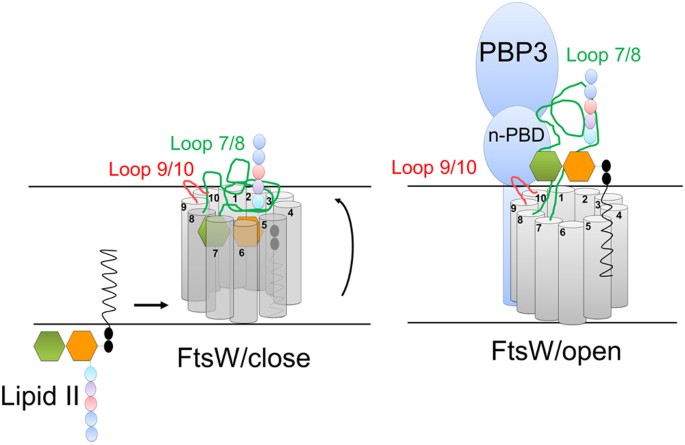
In addition, detection of FtsI was very sensitive to the level of fixation and degree to which cells had been digested with lysozyme as part of the permeabilization procedure necessary for antibodies to gain access to FtsI. Obtaining strong FtsI signals required high concentrations of primary antibody, inviting problems with spurious cross-reaction. In our hands, FtsI proved very difficult to detect consistently by IFM, presumably owing to its low abundance (∼100 molecules/cell) ( 19, 57). Polar FtsI was not expected, and we offered several potential explanations, including that it might be an artifact. We also observed polar localization in 10 to 20% of the cells. In these studies, FtsI was at the division site in about 50% of the cells. Previously, we used immunofluorescence microscopy (IFM) to show that FtsI is localized to the division site during the later stages of cell growth and throughout septation ( 57). Genetic and biochemical evidence indicate that FtsI is required specifically for synthesis of peptidoglycan at the division septum, while penicillin-binding protein 2 (PBP2), a homologue of FtsI, appears to be the primary transpeptidase for cell elongation ( 9, 50, 51, 58). FtsI (also called penicillin-binding protein 3 ) is a bitopic membrane protein with a large periplasmic domain that encodes an enzymatic activity (transpeptidase) involved in peptidoglycan synthesis ( 1, 10, 42). In this article, we identify some of the requirements for septal localization of FtsI of E. These findings allow us to rephrase the questions raised at the start of this paragraph: how do the division proteins localize to the division site? And what do they do once they get there? subtilis, three division proteins have been shown to localize to the division site: FtsZ, the FtsQ-homologue DivIB, and DivIC, which has no obvious homologue in E. Among the proteins known to localize to this site in E. Studies with Escherichia coli and Bacillus subtilis indicate that septum assembly is mediated by a large number of proteins that localize to the division site, where they are postulated to form a multiprotein complex sometimes referred to as the septalsome or divisome (for recent reviews, see references 12, 37, and 43). How the division septum is formed and how its formation is spatially and temporally regulated are among the most fundamental unanswered questions in prokaryotic cell biology. We conclude that FtsI is a late recruit to the division site, and that its localization depends on an intact membrane anchor. Septal localization depended upon every other division protein tested (FtsZ, FtsA, FtsQ, and FtsL).

In contrast, GFP-FtsI localized well in the presence of β-lactam antibiotics that inhibit the transpeptidase activity of FtsI.

Membrane anchor alterations shown previously to impair division but not membrane insertion or transpeptidase activity were found to interfere with localization of GFP-FtsI to the division site.

Localization of GFP-FtsI to the cell pole(s) was not observed unless the protein was overproduced about 10-fold. Consistent with previous results based on immunofluorescence microscopy GFP-FtsI localized to the division site during the later stages of cell growth and throughout septation. gfp-ftsI was expressed at physiologically appropriate levels under control of a regulatable promoter. We have constructed a merodiploid strain with a wild-type copy of ftsI at the normal chromosomal locus and a genetic fusion of ftsI to the green fluorescent protein ( gfp) at the lambda attachment site. One of these, FtsI (also called penicillin-binding protein 3) of Escherichia coli, consists of a short cytoplasmic domain, a single membrane-spanning segment, and a large periplasmic domain that encodes a transpeptidase activity involved in synthesis of septal peptidoglycan. Assembly of the division septum in bacteria is mediated by several proteins that localize to the division site.


 0 kommentar(er)
0 kommentar(er)
